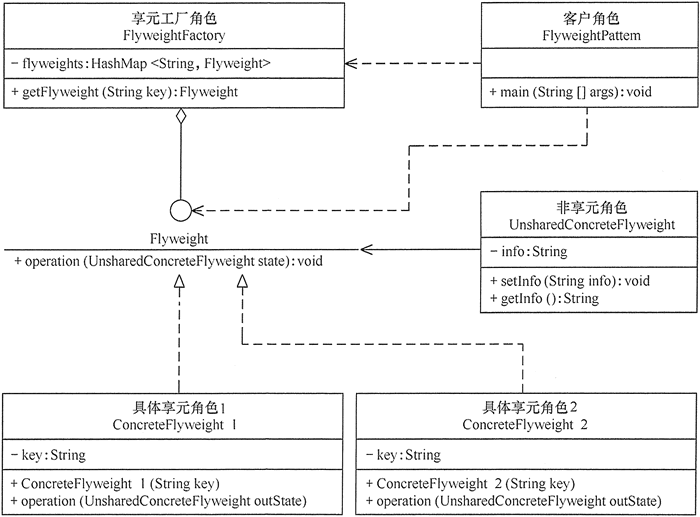定义
运用共享技术来有效地支持大量细粒度对象的复用。它通过共享已经存在的对象来大幅度减少需要创建的对象数量、避免大量相似类的开销,从而提高系统资源的利用率。
所谓“享元”,顾名思义就是被共享的单元。享元模式的意图是复用对象,节省内存,前提是享元对象是不可变对象。具体来讲,当一个系统中存在大量重复对象的时候,如果这些重复的对象是不可变对象,我们就可以利用享元模式将对象设计成享元,在内存中只保留一份实例,
复用现有的对象,而不是重复创建。
结构
主要角色
- 抽象享元角色(Flyweight):是所有的具体享元类的基类,为具体享元规范需要实现的公共接口,非享元的外部状态以参数的形式通过方法传入。
- 具体享元(Concrete Flyweight)角色:实现抽象享元角色中所规定的接口。
- 非享元(Unsharable Flyweight)角色:是不可以共享的外部状态,它以参数的形式注入具体享元的相关方法中。
- 享元工厂(Flyweight Factory)角色:负责创建和管理享元角色。当客户对象请求一个享元对象时,享元工厂检査系统中是否存在符合要求的享元对象,如果存在则提供给客户;如果不存在的话,则创建一个新的享元对象。
结构图

优点
节省内存
相同对象只要保存一份,这降低了系统中对象的数量,从而降低了系统中细粒度对象给内存带来的压力。
缺点
增加程序的复杂性
为了使对象可以共享,需要将一些不能共享的状态外部化,这将增加程序的复杂性。而且读取享元模式的外部状态会使得运行时间稍微变长。
不利于JVM垃圾回收
享元模式对 JVM 的垃圾回收并不友好。因为享元工厂类一直保存了对享元对象的引用,这就导致享元对象在没有任何代码使用的情况下,也并不会被 JVM 垃圾回收机制自动回收掉。因此,在某些情况下,如果对象的生命周期很短,也不会被密集使用,利用享元模式反倒可能会浪费更多的内存。
应用
棋盘和棋子
棋子除了坐标外,其他信息是共享的,共享这些信息,而不用为每个棋盘重复创建对象。
// 享元类public class ChessPieceUnit {private int id;private String text;private Color color;public ChessPieceUnit(int id, String text, Color color) {this.id = id;this.text = text;this.color = color;}public static enum Color {RED, BLACK}// ...省略其他属性和getter方法...}public class ChessPieceUnitFactory {private static final Map<Integer, ChessPieceUnit> pieces = new HashMap<>();static {pieces.put(1, new ChessPieceUnit(1, "車", ChessPieceUnit.Color.BLACK));pieces.put(2, new ChessPieceUnit(2,"馬", ChessPieceUnit.Color.BLACK));//...省略摆放其他棋子的代码...}public static ChessPieceUnit getChessPiece(int chessPieceId) {return pieces.get(chessPieceId);}}public class ChessPiece {private ChessPieceUnit chessPieceUnit;private int positionX;private int positionY;public ChessPiece(ChessPieceUnit unit, int positionX, int positionY) {this.chessPieceUnit = unit;this.positionX = positionX;this.positionY = positionY;}// 省略getter、setter方法}public class ChessBoard {private Map<Integer, ChessPiece> chessPieces = new HashMap<>();public ChessBoard() {init();}private void init() {chessPieces.put(1, new ChessPiece(ChessPieceUnitFactory.getChessPiece(1), 0,0));chessPieces.put(1, new ChessPiece(ChessPieceUnitFactory.getChessPiece(2), 1,0));//...省略摆放其他棋子的代码...}public void move(int chessPieceId, int toPositionX, int toPositionY) {//...省略...}}
文本编辑器中的样式
多个文字共享一个样式,而不是将样式信息塞到每个文字对象中。
public class CharacterStyle {private Font font;private int size;private int colorRGB;public CharacterStyle(Font font, int size, int colorRGB) {this.font = font;this.size = size;this.colorRGB = colorRGB;}@Overridepublic boolean equals(Object o) {CharacterStyle otherStyle = (CharacterStyle) o;return font.equals(otherStyle.font)&& size == otherStyle.size&& colorRGB == otherStyle.colorRGB;}}public class CharacterStyleFactory {private static final List<CharacterStyle> styles = new ArrayList<>();public static CharacterStyle getStyle(Font font, int size, int colorRGB) {CharacterStyle newStyle = new CharacterStyle(font, size, colorRGB);for (CharacterStyle style : styles) {if (style.equals(newStyle)) {return style;}}styles.add(newStyle);return newStyle;}}public class Character {private char c;private CharacterStyle style;public Character(char c, CharacterStyle style) {this.c = c;this.style = style;}}public class Editor {private List<Character> chars = new ArrayList<>();public void appendCharacter(char c, Font font, int size, int colorRGB) {Character character = new Character(c, CharacterStyleFactory.getStyle(font, size, colorRGB));chars.add(character);}}
Integer自动装箱
Integer i1 = 56; // 自动装箱,底层是Integer.valueOf(56),返回一个Integer对象。Integer i2 = 56;Integer i3 = 129;Integer i4 = 129;System.out.println(i1 == i2); // IntegerCache中缓存了-128 到 127 之间的整型值,此处返回的是同一个对象System.out.println(i3 == i4); // 自动装箱生成了两个对象,这里是False
一个小扩展:如果分析JVM,发现系统中-128 到 255 之间的数据占用的内存比较多时,可以将缓存最大值调整到255.
//方法一:-Djava.lang.Integer.IntegerCache.high=255//方法二:-XX:AutoBoxCacheMax=255
Long、Short、Byte 等,也都利用了享元模式来缓存 -128 到 127 之间的数据。
字符串常量池
String a=’123’
String b=’123’
String c=new String(‘123’)
其中a,b引用了常量池中的123。
扩展
跟多例的区别
应用享元模式是为了对象复用,节省内存,而应用多例模式是为了限制对象的个数。
享元不是缓存
享元是为了复用已有对象,减少空间占用。而缓存一般是为了提高访问效率。
与对象池、连接池、线程池的区别
享元的复用是为了节省空间。
连接池线程池的复用是重复使用已经建立好的连接或线程,节省时间。

